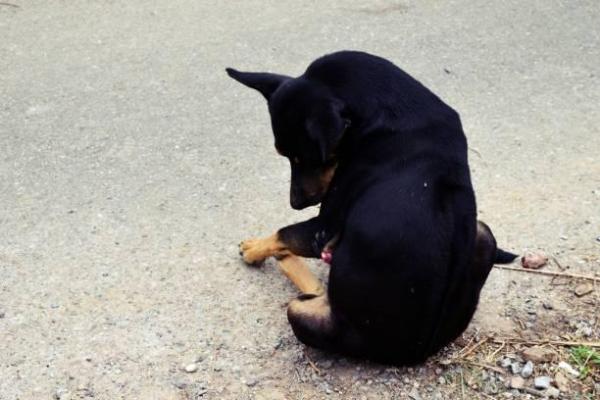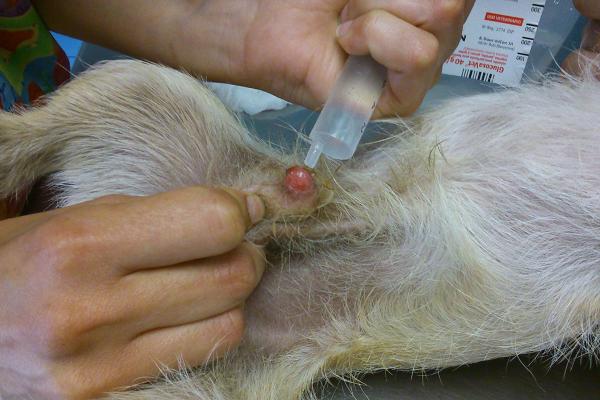Canine Priapism Causes and Treatment



See files for Dogs
Priapism in dogs is a medical problem that results in their penis being erect for a long period, extending past the time of sexual arousal. Specifically, the dog will get hard for longer than four hours. Such a prolonged period of erection chronically exposes the penis to the elements, something that can result in blood pooling, desiccation and ischemic necrosis. In the very worst cases, the damage to the penis is irreparable. If no treatment is available or it is administered too late, a penile amputation with perineal urethrostomy must be performed.
If you want more information about prolonged erection in dogs, we recommend you continue reading this AnimalWised article, where we talk about canine priapism causes and treatment.
What is priapism in dogs?
Priapism in dogs is a pathological condition characterized by the persistent erection of the penis in the absence of any sexual stimulus or other cause. While it is common for a dog to get hard without any obvious sexual stimulus, priapism occurs when the period of erection extends to longer than 4 hours as the penis will not soften. This makes urination difficult and predisposes the dog to permanent damage to the penis if it cannot be resolved.
In an initial stage of canine priapism, the penis can be manually reintroduced into the foreskin. This allows it to be differentiated from paraphimosis, a condition which occurs when there is an inability to reintroduce the penis inside the preputial sheath (dog foreskin). It is key to recognize priapism early in order to treat it as soon as possible and avoid consequences such as irreversible damage to the penis of our dogs.
Types of canine priapism
In the canine species, three types of priapism are usually distinguished. They are the following:
- Ischemic or low-flow priapism: it is the most common form, characterized by a painful erection of maximum rigidity and the absence of cavernous blood flow. When the dog gets hard for a duration exceeding 4 hours, it can behave like a compartment syndrome that requires urgent veterinary intervention. Otherwise, it could cause irreversible fibrosis and permanent erectile dysfunction.
- Non-ischemic, arterial or high-flow priapism: this is the less common presentation and is characterized by the uncontrolled entry of cavernous blood flow. It produces a non-painful and less rigid erection. This type of priapism requires timely treatment and evaluation, but it is not a veterinary emergency.
- Recurrent or recurrent priapism: this is a rare type of canine in which repeated episodes of prolonged erections occur, which are usually of the ischemic type. Treatment is individualized depending on the cause.
It is important to distinguish between a dog getting hard for prolonged periods and inflammation of the penis. Learn about the latter with our article on why my dog has a swollen penis.
Symptoms of canine priapism
The main symptom of priapism in dogs is a prolonged erection with the dog getting hard for long periods. When suffering from, dogs will generally present signs of severe pain, especially in the vast majority of cases affected by painful ischemic priapism. In cases of nonischemic priapism, pain is not a common symptom.
Other clinical signs that dogs with priapism may manifest include:
- Unsheathing of the penis
- Inflammation of the foreskin
- Hyperemia or redness of the penis
- Inflammation and redness of the foreskin (erythema)
Additionally, the dog will keep licking his penis and express restlessness due to the annoyance or discomfort of the prolonged erection. Learn about another reason a dog will keep licking their penis with our article on causes and treatment of balanoposthitis in dogs.

Causes of priapism in dogs
In the feline species, priapism can be observed secondary to prostate, urethral, penile or testicular stimulation. It can also be a postoperative complication of orchidectomy (castration) or secondary to spinal injuries. In the canine species, priapism is usually associated with spinal injuries that present with a parasympathetic stimulation of the pelvic nerve. Other causes that can cause priapism in dogs are the following:
- Viral type diseases
- Injuries to the cauda equina
- Use of tranquilizers such as phenothiazines
- Metastasis of some tumors
- Traumas in the bladder or perianal area
Learn about a cancerous disease which affects the penis of dogs directly with our article on transmissible venereal tumors in dogs.
Diagnosis of canine priapism
When our dog is continuously hard due to a prolonged penile erection, the caregiver will be able to observe the symptoms easily. Due to the similarity between conditions such as canine paraphimosis, the problem will need to be diagnosed by a qualified veterinarian. The distinction can be made when attempting to reinsert the penis into the foreskin. If this is possible, it indicates paraphimosis.
Diagnosis of canine priapism is made through a history and physical examination of the dog. This generally includes tests such as a complete blood count and blood biochemistry to detect alterations such as increased leukocytes, increased platelets, anemia or other organic markers. A blood count is particularly important if we observe that our dog is bleeding from his penis.
In addition, a urinalysis and diagnostic imaging tests such as ultrasound, x-ray or magnetic resonance imaging are performed to detect possible spinal cord or spinal injuries. An angiogram or Doppler ultrasound may be useful to evaluate blood flows and vascular compromise in the affected dog's penis.
Treatment of priapism in dogs
Treatment of priapism in dogs should be started as soon as the problem is detected, especially in the case of ischemic priapism. This is because vascularization may be compromised and dogs will experience increased discomfort and pain. In these cases, it is recommended to perform a puncture-evacuation of the cavernous bodies of the penis which aspirates and removes excess blood. It will also be washed with saline solution.
When a puncture-evacuation is unsuccessful, injection of an adrenergic agonist may be attempted as a first-aid treatment. The purpose of this procedure is to trigger a cellular response that simulates the effects of adrenaline that can reduce the erection. In case of failure, a second injection of adrenergic agonist could be chosen.
In the case of non-ischemic priapism, the problem may resolve spontaneously. If this does not occur, selective embolization of a cavernous artery can be considered as a treatment.
It is important to treat the underlying cause of priapism in dogs. The penis should be cleaned and disinfected to avoid infection if there has been contact with dirt or foreign bodies. If infection is already present, antibiotics should be administered. Signs of infection include pus coming from the dog's penis.
Despite treatments being administered and the correction of the underlying cause, in some cases the damage to the penis can be irreversible. In these circumstances, more drastic measures such as perineal urethrostomy and penile amputation may be necessary.

Home remedies for canine priapism
There are no home remedies to treat or relieve the pain of priapism in dogs, since the treatment will always be medical and/or surgical. Nothing can be done for the dog at home in this case beyond keeping the penis disinfected with saline.
If you notice that your dog maintains an erection beyond the sexual stimulus or encounter, it is important to go to a veterinary center immediately. They can determine what is causing this problem and treat it as soon as possible. As mentioned above, untreated priapism can have serious consequences on the penis of the affected dog.
Learn more about issues with a dog's sexual organ in our article on the anatomy of a dog penis.
This article is purely informative. AnimalWised does not have the authority to prescribe any veterinary treatment or create a diagnosis. We invite you to take your pet to the veterinarian if they are suffering from any condition or pain.
If you want to read similar articles to Canine Priapism Causes and Treatment, we recommend you visit our Reproductive system diseases category.
- Stornelli, M. A., Luzbel de la Sota, R. (2016). Manual of reproduction of production and companion animals. Retrieved from: https://ri.conicet.gov.ar/bitstream/handle/11336/116804/CONICET_Digital_Nro.3d71756b-0aa1-4ee3-aedd-d507de8806b9_A.pdf?sequence=2&isAllowed=y







